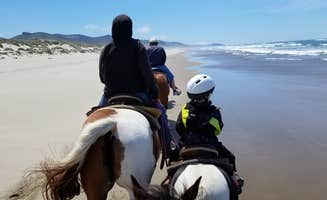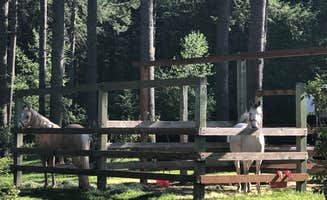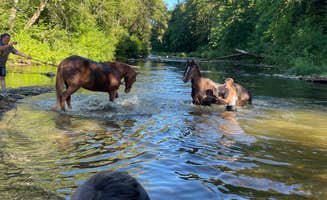Tillamook State Forest offers several equestrian camping options with direct access to bridle trails throughout the forest. Most horse camps remain open year-round with seasonal considerations for trail conditions. Riders should expect varied terrain from flat meadows to steep hillsides with elevation changes between 500 and 2,000 feet. The region receives approximately 70-100 inches of rainfall annually, creating lush vegetation and occasional muddy trail sections.
What to do
Trail riding connections: Hares Canyon Horse Camp connects to over 15 miles of dedicated equestrian trails. "We've enjoyed previous stays at L.L. Stub Stewart State Park in our tent and in one of the cozy cabins in the past. This time, we stayed overnight in our camper van at the top of the hill in Hares Canyon Horse Camp. Experiencing several of the many long trails on horseback was an unforgettable experience," notes Tanya B.
Explore forest service roads: For riders seeking longer excursions, forest service roads provide additional options. "This area is a really nice area to explore with some elevation gain. There are some existing campfire rings along the road. Boondocking is allowed. I've only been here in the winter when there are less people," says Terrell B. about Tillamook State Forest Stagecoach Horse Camp.
Night sky observation: The higher elevation camps provide excellent stargazing opportunities. "The top of the park shows a vast section of sky which is perfect for meteor shower watching," writes Jeff H. about Hares Canyon Horse Camp. Clear nights offer views of the Milky Way and occasional meteor showers, particularly during summer months.
What campers like
Camp facilities: Horse corrals and designated trailer parking make setup easier. "Each site has a picnic table, fire pit, and a corral. There is a double corral on the double sites," explains Stephanie Z. about Hares Canyon Horse Camp. These facilities eliminate the need for portable corrals or tie lines.
Site spacing: Many equestrians appreciate the ample room between sites. "Campsites are spaced well apart with lots of room in each site," reports Autumn R. about Jones Creek Campground, which serves as an alternative when horse camps are full.
Manure management: Horse camps provide designated manure disposal areas. "You must clean up after your own horse. Manure bin as well as shovels/brooms are provided onsite," notes Stephanie Z., making maintenance easier during longer stays.
What you should know
Water availability: Most horse camps have limited water sources. "Super big spots off side of forest roads. Nice and quiet back there other that locals and loggers through the night. Lots of trash too," warns Braxton C. about North Fork Trask. Pack extra water containers for horses, especially during summer months.
Reservation systems vary: Some camps operate first-come, first-served while others require reservations. "Friendly rangers patrol the camp regularly to make sure there are horses occupying each site," reports Tanya B. about Hares Canyon Horse Camp.
Wildlife encounters: Be prepared for wildlife interactions. "When we came back from the shower my wife and I observed a dark shadow darting from the table around the back corner of the tent... A bobcat to be exact," recounts Patrick G. Secure food and maintain awareness, especially at dusk.
Tips for camping with families
Alternate activities: Family members who don't ride can enjoy other recreation. "There is a two mile bike/walking path through the woods and along the bay. The beach is only a five minute walk away," shares smittie about Nehalem Bay State Park Campground, located 23 miles from Tillamook.
Educational opportunities: Incorporate learning about forest ecology. "Definitely check out the Tillamook Forest Center, you can even hike over from the campground," suggests Aria R. The center offers exhibits about forest management and history.
Safety protocols: Establish clear rules for children around horses and trails. "When we visited the tide had gone out leaving little tide pools around. It was very nice," mentions Deanna F., highlighting opportunities for tide pool exploration as an alternative activity.
Tips from RVers
Hookup logistics: Position your rig strategically for both horse access and utilities. "Our spot was very spacious as the length was 45 feet deep on asphalt. It had a picnic table and a fire ring in a well-groomed gravel area about 30' x 30'. The back of our spot was against very high trees," describes Robert D. about Dairy Creek East.
Cell service considerations: Connectivity varies significantly throughout the region. "The water and sewer hookups were in the middle of the site, with electric being at the back of the pad. The water pressure was not very good at around 35 psi. We had a clear shot to the north sky for Starlink, but it's doubtful we'd get a southern sky shot from this site due to the mature trees. We got 3 bars LTE on Verizon," notes MickandKarla W.
Off-season advantages: Consider camping during slower periods for better site selection. "During the main season when the whole place is open you can usually find a spot last min," advises Shane, though recent policy changes may affect availability.




